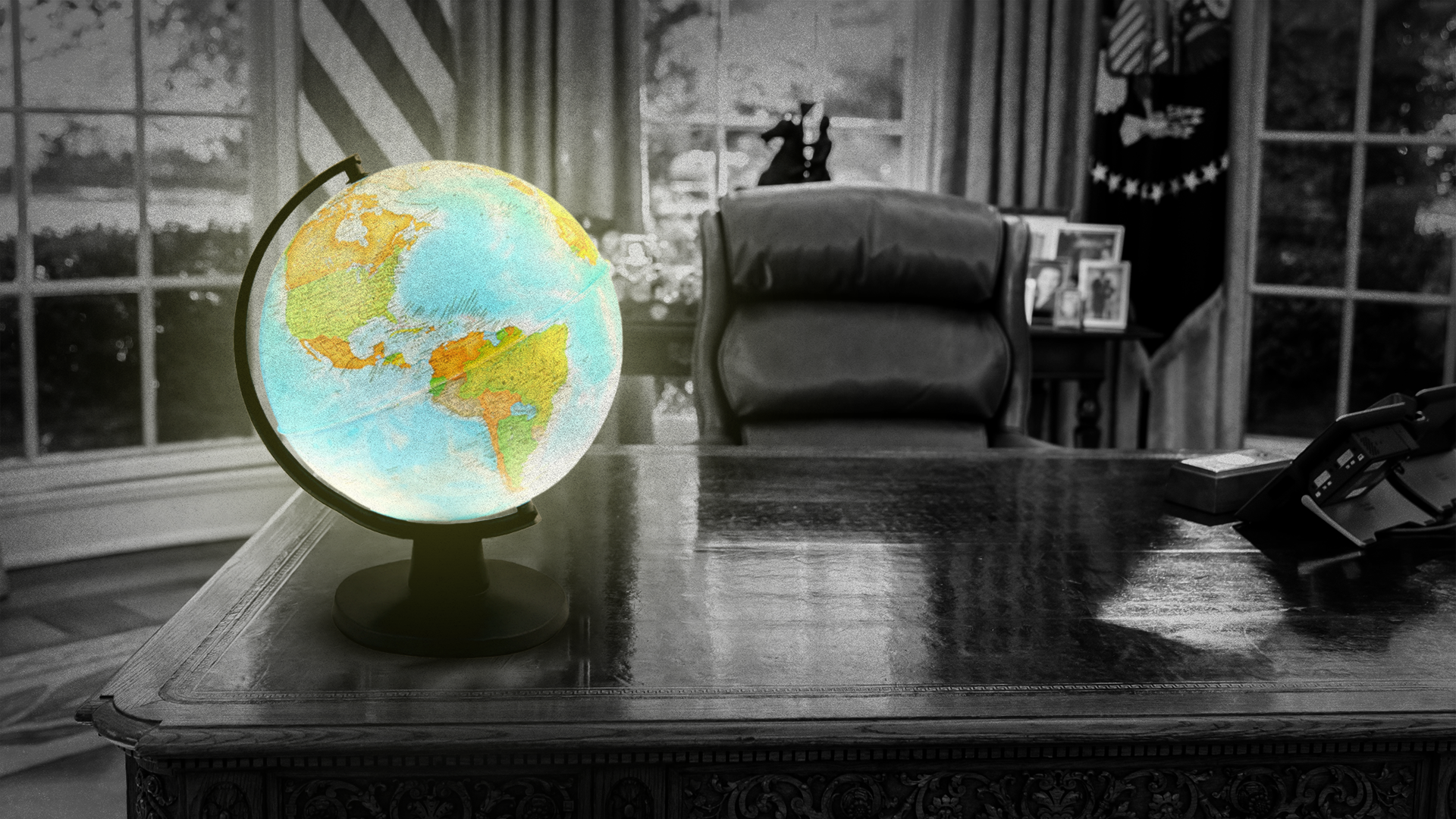Defense Priorities organized this symposium to stimulate thinking about policies that should be adopted by the incoming administration. Top experts shared their insights in an effort to inform and improve U.S. policy. Each contributor provided an answer to the same question: “What is the most important, realistic policy the incoming administration should adopt to advance U.S. national interests?”
Rebalance the U.S.-European defense relationship
The incoming Trump administration is uniquely well-positioned to shift a significant portion of the fiscal and manpower costs of defense to the United States’ capable allies in Europe.
The United States has always borne the lion’s share of spending and of providing military capabilities within the NATO alliance. Ironically, this imbalance between the U.S. and Europe has only grown worse during the post-Cold War period, as many European states drew down on defense spending to the point where they could not even defend themselves.
Despite this, for years, it was largely unthinkable that any U.S. leader would pull back from the commitment to Europe. Even the Obama administration’s mild criticism of European underspending on defense was seen as beyond the pale as recently as 2011.
But with the rise of China, growing public concern about the cost of the war in Ukraine, and U.S. defense stockpiles stretched thin, it’s increasingly clear that this is not a time for the U.S. to tolerate allied free-riding.
Nor are long-running arguments that Europe cannot provide for its own defense plausible. America’s European allies are rich and technologically advanced, and though an immediate U.S. pullback from the continent would leave gaps that would be impossible to fill, a more gradual shifting of the burden to European states would push them to make the tough budgetary and organizational choices needed to make a European defense more viable. A gradual pullback from European security—beginning with Ukraine spending and moving on to NATO troop commitments—is eminently achievable.
Donald Trump himself is in a strong position to make this shift happen. Though actually withdrawing from NATO might require congressional action, mere shifts in troop deployments or pressure on allies to spend more are within the president’s existing authorities. Trump ran clearly on an “America First” foreign policy, having repeatedly emphasized U.S. costs in Ukraine and Europe. In terms of rhetoric and personality, the incoming president is thus uniquely well-placed to negotiate with European leaders from a position of strength; he outlasted almost all European leaders from his previous term and was reelected with a popular mandate.
Just as only Nixon could go to China, it may well be that only Donald Trump can rebalance the U.S.-European defense relationship. The new administration should make it a top priority.
Make America’s allies sweat
Donald Trump makes U.S. allies nervous, and that is potentially a good thing. Trump should sow allies’ doubts about the strength of U.S. military commitments and reduce the number of forces deployed in their defense. By letting allies sweat, Trump will encourage them to take on more of the burden of balancing threats, reduce costs and risks borne by Americans, and enhance U.S. leverage over allies.
Last time he was president, Trump was rhetorically tough on allies, especially in Europe, but he proved more bark than bite. While he railed against America’s NATO allies for insufficient spending on defense, he also reassured them the United States was committed to their defense under Article 5 of the NATO treaty.
During his last year in office, Trump announced plans to move some U.S. forces out of Germany, but never managed. His famously high regard for Russia did not stir him to prevent NATO’s expansion to Montenegro. Trump strengthened informal U.S. commitments to Israel, the United Arab Emirates, and Saudi Arabia. His administration took a hard line on China and left U.S. alliances essentially as he found them in Asia.
This time around, Trump should take a different tack. He should weaponize the uncertainty created by his well-known ambivalence toward allies, not soften it in the name of reassurance. That need not mean renunciation of every alliance, but rather simply stating that nothing, including Article 5, compels the United States to make war for its allies. In addition, Trump should begin a process of reducing U.S. garrisons in allied states, expecting them to handle more of the burden of their defense.
This will horrify the bulk of Washington’s foreign policy establishment, and probably even some of Trump’s own advisors. They fetishize alliances, believing the United States must always strive to reassure its 50-plus allies and even quasi-allies of its total commitment to defend them, lest they are conquered by China, Russia, or Iran, or simply give in and do their bidding—bandwagoning.
This establishment view is wrong and corrosive to American interests. For one, it ignores the balance of power. Russia’s poor military performance in Ukraine underlines its limited threat to Europe, and European states’ ability to contain it. Geographic obstacles and rich rivals contain any Chinese ambitions toward regional hegemony. No state, certainly not Iran, is poised to assert dominance in the Middle East.
Second, U.S. allies, if seriously threatened, will likely balance rather than bandwagon. They have lots of capacity to balance these threats. But allies have little incentive to do that as long as U.S. rhetoric and deployments say not to worry.
Third, by treating alliance commitments as untouchable, Washington undermines its ability to compel allies to make concessions in other areas like trade. Without fear that U.S. protection can be withdrawn, at least in part, allies are unlikely to make concessions to keep it. Removing promises—and better yet troops—will immediately enhance U.S. leverage over allies.
U.S. interests demand that allies get less reassurance, not more.
Position the P5 as the new global diplomacy cornerstone
In the alphabet soup of international organizations, there is always some big conference going on. Whether it’s a NATO summit, the COP, a BRICS meeting, or a gathering of the G20, these groupings never seem to have the right players around the table to get serious work done.
This is a natural outgrowth of woke theorizing and political correctness that prioritize virtue signaling and equality. Under the Trump administration, the United States should undergo a shift in emphasis to pragmatic diplomatic results, which would serve the countries of the world much better.
Such a shift would take a P5 summit as its cornerstone. P5 refers to the five permanent members of the UN Security Council, the United States, the United Kingdom, France, China, and Russia. These same five countries constituted the major, victorious allied powers that won World War II. Some may view that elevation as archaic, but these countries are still the world’s foremost military powers. And military power still counts for a lot in world affairs, as the last few years have amply demonstrated.
Since realists regard power, especially military power, as the primary determinate in many if not most global political developments, it is highly appropriate that the leaders of the P5 should gather frequently.
The P5 summit would also, by design, be guided by restraint, since these powers represent a diverse group, with a substantial and obvious fracture between the Western countries and the two Asiatic powers. Indeed, helping to bridge the chasm dividing East and West would be a difficult task, but one made easier by frequent leader meetings.
Leadership summits present an extraordinary opportunity to make breakthroughs and cut through bureaucratic resistance to compromise. One need only consider the example of the Reykjavik summit in 1986 between Ronald Reagan and Mikhail Gorbachev to consider how such meetings can mitigate rivalry dynamics and develop new, unexpected, and positive trajectories for world politics. The extraordinary discussions that occurred at Reykjavik laid the basis for ending the Cold War.
Unfortunately, today, most global summitry serves merely to consolidate the various groupings within the two major blocs, deepening the “new cold war” that has had myriad nefarious effects, including fueling regional wars and arms races. True, Presidents Joe Biden and Xi Jinping have met a few times in the last couple of years, most recently in San Francisco. But these have amounted to brief “side discussions” amid larger multilateral fora.
Such key bilaterals should continue and be afforded extra time and effort. But a multilateral P5 would more substantially help to stabilize our troubled world. The P5 would have the best possible chance of setting the parameters to end the catastrophic Ukraine war. The group would also constitute an ideal forum to explore future possibilities for nuclear arms control. Trump should make it a priority.
Say ‘no’ to European defense spending targets, say ‘yes’ to drawing down U.S. forces
The Trump administration should advance a detailed plan with clear benchmarks and a timetable for shifting primary responsibility for Europe’s security and defense from the United States to the Europeans themselves.
President-elect Donald Trump has long railed against America’s NATO allies for not spending more on their own defense and leaving Americans to foot the bill. In his first sit-down interview since winning reelection, Trump warned that if European allies failed “to pay their bills,” he would “absolutely” consider withdrawing the United States from the alliance.
He is not wrong about languid European defense spending, but he is not entirely right either. European countries have chronically underfunded their militaries for decades, resisted addressing the fragmentation of Europe’s defense industry, and refused to borrow money jointly for defense projects.
Even with the largest armed conflict in Europe since World War II raging on their doorstep, only two-thirds of NATO members (23 of 32) met their commitment to spend at least 2 percent of their gross domestic product (GDP) on defense in 2024. And some—like Germany—employed (shall we say) creative accounting to meet that target.
Remarkably, Trump’s threats may already be having an effect. European NATO states are holding talks about increasing their defense spending to 3 percent of GDP by 2030.
But the president-elect’s singular focus on defense spending misses the broader point: bigger European defense budgets alone will not do much to advance U.S. interests unless they are tied to a concrete plan and timetable for shifting the deterrence and defense responsibilities of NATO’s conventional forces from the United States to European allies.
To implement burden shifting, the Trump administration should take three steps. First and foremost, it should refuse to cut a deal in which European nations raise their defense spending by half or even a full percentage point in exchange for Washington maintaining a large military presence on the continent.
Second, it should establish a clear timeline for transitioning the bulk of NATO’s troop presence on the eastern front from the United States to European militaries. To start, the Trump administration should announce a withdrawal over the next two years of the 20,000 American forces surged to countries like Poland and Romania following Russia’s invasion of Ukraine. This should give European allies sufficient time to plan for the American drawdown and to replace American units with European ones.
Finally, the Trump administration should initiate a phased drawdown of U.S. forces from the rest of the continent over the next 10 years, detailing which units and capabilities will be withdrawn when. This information would assist NATO as an organization, and particularly its European member states, to prepare accordingly. For example, what additional missions will European militaries need to take on? And what forces and capabilities will NATO need to cover those missions? The answers to these questions should serve as a basis for identifying European capability shortfalls, driving up spending, and guiding procurement decisions.
U.S. political leaders have long pleaded with Europe to get serious about its own defense but stopped short of forcing change. This strategy of strategic patience has clearly not worked. It is time to back up Washington’s words with a plan.
Put America first but not alone
Joe Biden sought to resurrect U.S. leadership in the world. His “America’s back” slogan appealed to a pre-Trump status quo.
If Biden uncritically touted the value of alliances and reflexively invoked an idealized rules-based international order, President-elect Trump risks making the opposite mistake: uncritically dismissing the value of alliances and reflexively jettisoning the norms of that order. After all, many of those alliances, and much of that order, though vestiges of other geopolitical eras and overdue for updates, have largely served U.S. interests.
Trump and Trumpism are, among other things, a response to the discontents of current foreign policy conceits. Facing new geopolitical realities and domestic constraints, America can’t shape the world as it once did. Trump gives voice to the many Americans dissatisfied with how the United States previously shaped the world. Multilateral institutions can draw cumbersome rules and frameworks that bind America’s hands, and allies have typically passed the costs of their security onto American taxpayers.
But these new realities and constraints should lead Trump to reinvigorate rather than renounce alliances. As it confronts mounting debt, the U.S. can hardly afford to continue being the primary counterbalance to Russia in Europe, Iran in the Middle East, and China in Asia. The less unipolar the world, the more important America’s alliances.
But whereas the United States largely used its post-Cold War alliances to shore up political and economic alignment in exchange for U.S. protection, Trump has an opportunity to nudge Europe out of its complacency and bring back the traditional purpose of alliances: a way to aggregate capabilities against a common threat.
France’s Emanuel Macron has long advocated for a more robust independent European military capability, and the Nordic and Baltic countries are stepping up too. Still, as Europe’s largest economy, Germany remains stubbornly unwilling to change course. Trump’s attitude toward Ukraine’s security assistance makes this clear: Europe must be fit and see fit to arm Ukraine or no one will.
While South Korea, Japan, and Taiwan have maintained stronger independent military capabilities, the same logic applies to East Asia. Japan and Taiwan have mostly failed to update their force structures and invest in domestic defenses at a level which would credibly deter China, likely assuming the U.S. will save the day if it’s ever necessary. Japan needs a stronger navy and Taiwan needs to spend more on defense, investing in asymmetric capabilities rather than buying small numbers of high-end systems that would be useless against Chinese aggression.
America First need not be America Alone. Trump has a once-in-a-generation opportunity to reimagine America’s international leadership. Like a visionary executive whose successful enterprise creates wealth for all sorts of stakeholders, Trump should see international politics as not always zero-sum. America First doesn’t have to be detrimental to America’s allies and trading partners.
Heretics can be as blinded by dogma as the orthodoxies they attack. Ideological opposition to alliances can be as strategically muddling as ideological support for them. U.S. leadership in international organizations is an opportunity to imbue those institutions with democratic values and influence outcomes which benefit Americans. While America can and should start shifting the burden of collective defense, America’s alliances have slowed the spread of nuclear weapons and enabled countries to grow and prosper in ways which benefit the United States.
With some of the strongest democracies in Europe and Asia rife with political discord, President-elect Trump could hold out the United States as a champion of international cooperation even while he’s buoyed by populist support and prioritizes U.S. interests. If under Trump the U.S. leads the way in boldly and creatively addressing shared challenges—from cyberwarfare and terrorism to nuclear proliferation and the rise of powerful illiberal challengers to global norms—it would not only position America first but would help make America great(er).
Cut the U.S. military footprint in Europe
During his first administration, Trump was loudly skeptical of the decades-long U.S. military commitment to Europe, calling NATO “obsolete” and berating European allies as free-riders.
For all the tough talk, however, Trump did little to reduce the U.S. share of Europe’s defense burden. He tried, halfheartedly, at the end of his term, calling for the withdrawal of 12,000 U.S. forces from Germany, but he ran out of time to force through even this meager move.
With his second chance, Trump should move decisively to significantly reduce the U.S. military footprint in Europe from its current total of 100,000 forces, starting with the additional troops that President Joe Biden’s administration deployed during the Ukraine war and then pushing toward the post-Cold War low of about 60,000 achieved in 2013. To accomplish this ambitious goal, Trump will need to draw down forces immediately, without a lengthy global posture review, which would give opposition time to mobilize.
Withdrawal would serve U.S. interests in two ways.
First, a smaller U.S. military presence in Europe would accurately reflect U.S. national security priorities and free up scarce dollars, troops, and equipment to support operations in the Indo-Pacific theater. As the first Trump administration acknowledged, China poses the greatest challenge to U.S. national security interests because of its growing ability to project military power across East Asia, reduce U.S. economic access to the region, and even, in the extreme, pose a direct threat to the U.S. homeland.
Though nuclear weapons mean that Moscow will never be irrelevant, the economic and military threat Russia poses to the United States and its interests is limited. Washington does not want to see Russia overrun Europe, but the Ukraine war has demonstrated Russia’s weakness and offered evidence that Europe could defend itself, even without U.S. support. Large U.S. deployments in Europe, then, unnecessarily drain U.S. readiness and resources needed elsewhere.
Second, removing a substantial number of U.S. forces would send a clear signal that Trump is serious about shifting the burden of Europe’s defense to the region itself. Trump is not the first president to bemoan the underspending of NATO allies. However, because the United States has always rescued Europe in times of crisis, warnings about the limits of U.S. support have no credibility. Only a sizable and quick withdrawal will catalyze long-needed changes to Europe’s defense spending and the development of a truly European defense concept and posture. Notably, in the rare instances when the United States has left allies facing a worsening security environment to respond on their own, they have stepped up their defense spending.
As he draws down the U.S. presence in Europe, Trump should start with the 20,000 military forces added after 2022, especially those based on NATO’s frontline. With Russia unlikely to move against NATO allies while still tied up in Ukraine, these forces are unnecessary for deterrence. Next, Trump should redeploy units and assets that could support U.S. operations in the Indo-Pacific, including some air and naval forces and some air defense and sustainment capabilities. Finally, U.S. forces that disincentivize Europe from building its own ground combat assets should return home, including U.S. Army brigade combat teams based in Poland and Germany.
Trump will face resistance in Washington and from abroad if he pursues this path. He should remind critics that the U.S. military presence in Europe was never intended to be enduring.
Withdraw U.S. troops from Syria—Counterterrorism is remote work
The Trump administration should finally end the deployment of 2,000 U.S. troops to Syria and bring those soldiers home before conditions deteriorate amid the Syrian revolution. Their presence risks drawing the United States into yet another Middle Eastern quagmire for little gain, because their primary mission—counterterrorism—has become remote work.
The U.S. originally dispatched forces to Syria in 2015 to fight the Islamic State in Iraq and Syria (ISIS), which had established a “caliphate.” But local actors like the Kurdish-led Syrian Democratic Forces (SDF), with help from the United States, defeated ISIS in 2019 and stripped it of its territory. What little is left of the original Islamic State remains well contained by its many regional enemies, including Hayat Tahrir al-Sham (HTS), which runs the new regime in Damascus.
Yet the New Year’s Day terrorist attack that killed 15 revelers on Bourbon Street in New Orleans, conducted by a lone wolf U.S. citizen apparently “inspired” by ISIS, has regenerated fears of terrorist groups establishing “sanctuaries” in Syria of the sort al-Qaeda had in Afghanistan ahead of the 9/11 attacks.
That logic is wrong. These days, boots on the ground aren’t needed to deny “sanctuaries”—if they ever were—because there is no such thing as a “sanctuary” from U.S. reach. U.S. intelligence and strike capabilities have grown so sophisticated over the past 25 years that they can operate fully over-the-horizon. The troops in Syria can come home without degrading counterterrorism efforts against ISIS remnants, or anyone else.
The U.S. withdrawal from Afghanistan, for example, did not hamper Washington’s ability to discover the deadly plots against Russia and Iran in 2024 by ISIS-Khorasan (ISIS-K). Those plots succeeded not for lack of detection, but because the authorities in Moscow and Tehran declined to take U.S. intelligence warnings seriously. U.S. intelligence also discovered and, thankfully, disrupted the 2024 “ISIS-inspired” plot against a Taylor Swift concert in Vienna because Austrian authorities did heed U.S. tip-offs about the plan.
Meanwhile, Syria is in revolution—and revolutions tend to get bloody. The relatively modern, relatively secular Assad dynasty that ruled for five decades has been toppled by Islamic fundamentalists. Significant bloodshed has been avoided thus far, but if Syria follows the historical trend, we are likely to see violence and upheaval as competing revolutionaries struggle to impose their vision upon society. The French Revolution and the Russian Revolution, among others, spurred years of civil war and domestic unrest before coalescing into a new equilibrium.
Keeping troops in Syria amidst a revolution endangers them unnecessarily and risks drawing the United States into a faraway conflict of little consequence to its national security. The Trump administration can remove U.S. troops and still accomplish its counterterrorist objectives. There is no time to waste.
End Europe’s learned helplessness
Europe is the theater in which the new Trump administration can make the biggest change for the better. NATO Europe’s combined GDP is 10 times greater than that of its adversary Russia. Its population is four times larger. Its current military spending is more than three times greater. This is not a continent on which the United States needs to lead.
Yet in every meeting with European officials, one hears the same song of learned helplessness. You can’t trust us. If you leave, we will do something so self-destructive that it will wind up hurting you. We can’t talk to each other or work together without you telling us what to do. We dislike cooperating with each other even more than we fear Russia. We are congenitally incapable of fighting (or even deterring), and if Russia wagged its nukes at us, we would bow and do whatever they say.
Either the act is uniformly well-rehearsed, or the officials have fully internalized their own propaganda.
Trump should end this charade.
Germany is the center of the problem in Europe and should be the center of the solution. Unless forced to do so, Germany will never seriously recommit to its own defense, much less a leadership role in European security. Accordingly, the United States should force the issue by starting to remove its own forces from Germany, with a focus on loosening “teeth” versus “tail.”
The place to start is in Vilseck, Germany, with the 2nd Cavalry. This regiment contains approximately 5,000 U.S. troops who are at the forefront of the effort to deter Germany’s enemies and defeat them if necessary. Beginning to withdraw the 2nd Cav would be a loud signal to Berlin that they had better prepare.
A second place to begin drawing down U.S. forces in Germany is at the Ramstein Air Base, the largest concentration of Americans living overseas. More than 50,000 American personnel are based at Ramstein to support the U.S. Air Forces in Europe. One objection to drawing down from Ramstein is that the base supports U.S. operations in the Middle East. But since those missions have been costly and dismal failures for over a generation, the response should be that we’re going to do fewer of those, too.
By laser-focusing on withdrawing U.S. combat forces from Europe, President Trump can get Europe’s attention and force them to look the problem squarely in the eye: the cheap ride is over.
Trump told Oprah Winfrey in 1988, “I’d make our allies pay their fair share.” If he can get them to pay their fair share, America will not have to pay much at all. And that would be a Zeitenwende for American strategy.
Finally pivot America’s attention to Asia
The most important foreign policy issue for the incoming Trump administration—and every administration for the foreseeable future—will be managing the United States’ relationship with China. While there is broad agreement that the rise of China poses the most significant foreign policy challenge since the end of the Cold War, the issue has slipped into the background during the Biden administration, even as U.S.-China relations have continued to deteriorate.
While U.S.-China relations will inevitably be defined in large part by competition, a clear-eyed understanding of U.S. interests demands that this competition be kept limited. In many ways, successfully competing with China economically, technologically, and militarily depends less on “getting tough” with Beijing and more on constructive efforts at home and shifting security burdens to allies and partners in Asia.
The first thing the Trump administration should do is acknowledge China’s core national interests where they do not conflict with those of the United States. This includes recommitting to the substance of the One China policy, re-adopting a position of “strategic ambiguity” regarding Taiwan, avoiding treating China as illegitimate (e.g., referring to the PRC as the CCP), and refraining from signals of support for regime change or separatism. It also means dispensing with the Biden administration’s “democracy vs. autocracy” rhetoric, maintaining regular dialogue with Beijing, and establishing crisis management mechanisms.
The second thing the Trump administration should do is shift the burden of deterring potential Chinese expansionism to East Asian states, acting as a backstop rather than a unilateral security guarantor. By investing in accessible and relatively cheap defensive capabilities, even small states can maximize the defensive advantages presented by East Asia’s island geography. This would deter China from aggression against its neighbors and prevent its domination of the shared waters of the South China Sea. This defensive approach would make regional deterrence more resilient and flexible, while also reducing direct U.S.-Chinese tensions and the risk of a great power war.
Finally, Trump should shift the focus of economic competition away from attempts to isolate China and towards bolstering the United States’ own indigenous capacity. The U.S. needs to rebuild its manufacturing base and become competitive again in “traditional” industries like shipbuilding and steel alongside high-tech industries like semiconductors. Tariffs are only one in a range of industrial policy tools to pursue this goal, like subsidies and local content requirements. The U.S. should create policies that attract STEM students to engineering and skilled manufacturing jobs, not just the highest value-added sectors in software and design.
Refocusing on the U.S.-China relationship inevitably means avoiding getting bogged down in Europe and the Middle East. These entanglements not only drain much-needed resources and attention, they also complicate the United States’ ability to limit competition with China, push rivals and adversaries together against the U.S., and heighten escalation risks while making crises more intractable. The incoming administration should correspondingly shift the United States’ attention towards Asia while rebuilding industry and infrastructure at home.
Recommit to the 'One China' policy
A war with China would clearly not be in the U.S. national interest. The second Trump administration should begin by acknowledging this.
The United States and China are the world’s two largest economies. A war between the two would likely have disastrous consequences for both, with ripple effects felt throughout the rest of the world.
Different simulations and war games produce different outcomes as to who would prevail, but all of them show that such a war would extract a very high cost from the U.S. military. This is because such a war would be easier for China fighting near its borders than the U.S. having to maintain a 6,000-mile-long contested logistics tail against a regional power with modern weaponry.
In other words, this would not be the same as toppling Saddam Hussein or the Taliban, both of which were feeble military opponents. Moreover, U.S. military engagement in the Taiwan Strait and East China Sea would likely entail missile or air strikes on mainland China, which raises the prospect of escalation with a nuclear power with intercontinental ballistic missiles capable of striking the U.S. homeland.
So not only is a war with China an uncertain proposition, it is also very high risk. Therefore, the incoming Trump administration needs to craft its China policy to avoid the potential for a war to erupt—not at all costs but at reasonable and realistic costs.
The new administration’s policy should incentivize Beijing to live with the status quo of a U.S. “One China” policy that formally recognizes the PRC as the sole legal government of China and acknowledges Taiwan as part of China but without Taiwan directly under China’s control. This is a classic case of not letting the perfect be the enemy of the good, allowing Taiwan to essentially be independent such that the U.S. has unofficial relations with it, including arms sales of defensive weaponry to Taiwan.
Knowing the Xi regime has a stated goal of being able to annex Taiwan, America’s China policy should not be provocative (for example, stationing troops on Taiwan or engaging in joint military exercises with Taiwan) or otherwise give Beijing reason to take preemptive military action that could trigger a U.S. military response.
The framework for such a policy should put the Chinese military threat in perspective by acknowledging that China does not have global power projection capability and so is not a direct threat to the U.S. homeland and has limited capability to dominate East Asia. Moreover, U.S. friends and allies in the region have the economic capacity, and should shoulder the primary responsibility, for balancing against and deterring Chinese aggression.
Instead of increasing the U.S. military presence in the region (which can be viewed as provocative by Beijing), the U.S. needs to encourage its friends and allies to act in their own security interests by acquiring anti-access/area-denial (A2/AD) capabilities to improve deterrence; deepening military-to-military cooperation; increasing joint operating capabilities, command and control, and communications; and conducting joint military exercises.
Address the threat of nuclear proliferation cascades
The most pressing security concern facing the incoming Trump administration is the threat of nuclear proliferation cascades. The pursuit of nuclear weapons in unstable regions not only increases the risk of mirrored pursuits in non-nuclear neighbors but can lead to military re-posturing in nuclear powers and embolden newly armed states to behave aggressively.
Iran poses the greatest threat today of sparking such a proliferation cascade. It is surrounded by regional conflicts, with proximate proliferation risks (Saudi Arabia and Iraq), nuclear-armed rivals (Israel), and interests that are often directly at odds with Washington’s.
The most important policy change the Trump administration should make is to reduce the United States’ reliance on economic sanctions as a way to stem nuclear proliferation. Countries like Iran with a history of resisting sanctions already have trade and policy measures in place ready to undermine international sanctions, and have proven capable of enduring great costs in defense of their nuclear programs. This renders sanctions ineffective as tools of counterproliferation against Iran.
What’s more, sanctions are actually counterproductive. They hinder the development of industry that might open Iran’s economy and undermine Tehran’s policies of animosity, and have increased anti-Western sanction-busting cooperation between China, Iran, Russia, and North Korea. They can tie a presidential administration’s hands, requiring expensive multinational enforcement commitments even after they have proven ineffective, or else risk painting the U.S. as a weak enforcer to all other potential proliferators and thereby undermining any future sanctions efforts.
Nuclear sanctions more than any other response can serve as a ball and chain, tying the administration to a hopeless and expensive endeavor or risk undermining future sanction efforts.
Instead of relying on sanctions, the United States should consider the use of limited nuclear cooperation agreements (NCAs). These agreements have the greatest chance of controlling Iran’s nuclear program and the lowest risk of counterproductively increasing proliferation.
Iran will never agree to total nuclear abstinence or overreaching issue-linkage (like injecting ballistic missile limits). The Iranian government has tied its domestic and international prestige to harnessing nuclear technology, providing cheap domestic energy, and freeing its oil and gas reserves for lucrative export.
But NCAs can ease Iran’s shift to more proliferation-resistant technology while requiring strict inspections that deter overreach and provide early warning for violations. The trick is finding limited measures that both can accept. The U.S. cannot directly supply without a 123 Agreement—which requires congressional review and imposes strict oversight over all potential nuclear facilities—and this is a negotiation nonstarter for both. Iran cannot cobble itself to enduring dependence on foreign powers.
A sweet spot with regard to Iran could be enlisting private corporations to replace Iran’s risky heavy-water reactors (like Arak and the now-dormant Khondab) with more proliferation-resistant light-water reactors. Coupling this with collection and the reprocessing of spent fuel would mitigate the risk of Iran developing a plutonium bomb while also reducing Iran’s operating costs for civilian energy. Together these efforts would inject oversight and limits into both ends of the nuclear cycle, while reducing financial and technological burdens for Tehran.
The best method for delivering these policy changes is through private conversations with both Tehran and U.S. allies. Unpredictable public statements can be misinterpreted as insincere public pandering, communicate inaccurate red lines, or invite complicating domestic debate. This does not mean public messages are never appropriate, but they are most effective when they follow more complete private conversations.
Right-size the Pentagon through a competition
President-elect Donald Trump seems to believe the U.S. government spends money wastefully. He also seems to believe that U.S. grand strategy requires a major rework. He should explore these two beliefs together with a policy and budget competition at the Pentagon.
Here is how it would work. Three policy-strategy-budget teams would be assembled. Each team would include new political appointees, senior civil servants, intelligence community experts, and military officers. Each team would be asked to cut $50 billion a year from the Pentagon top line over the next 10 years. Each would also be asked to reallocate $50 billion a year.
Each team would need to explain its cuts and its reallocations in strategic terms, including how their plans conform to their interpretation of President Trump’s strategic vision as they understand it. The teams would not be permitted to discuss their plans with one another. But the approach of each team would be up to them. The teams might even come up with identical plans, which might please or displease the president.
At the end of the competition, President Trump would be briefed and could choose the winner. If no team managed to produce a successful proposal, the Defense Department could—as most Pentagon bureaucrats, military officers, and congressional defense experts surely expect it will—continue business as usual.
Prioritize the Defense and Security Dialogue with Europe
In his first year in office, President Trump should prioritize the U.S.-EU Defense and Security Dialogue with the goal of creating a 10- to 15-year vision for European strategic autonomy.
Announced at the U.S.-EU Summit in 2021, the Biden administration and the EU created the Dialogue to “strengthen EU-US strategic partnership in security and defence and the transatlantic bond.” It has met only twice since its creation—once in 2022 and once in late 2023—and only at the deputy assistant secretary of state and deputy assistant secretary of defense level, to discuss Ukraine, the Western Balkans, and defense industry cooperation.
During these meetings, the officials “exchanged updates on [their] respective security and defense policy frameworks and welcomed the signing of the Administrative Arrangement between the European Defence Agency and the U.S. Department of Defense.” Clearly the Biden administration has underutilized the Dialogue, and there is not much to be said as far as accomplishments go.
This is a missed opportunity.
President Trump should elevate this Dialogue so it meets at the undersecretary of state and undersecretary of defense level, with the newly appointed defense commissioner leading the European side. The underlying goal should be to determine where the EU must pursue defense industrial development independent of the United States over the next 10–15 years. It’s not enough to highlight where the two sides must continue to cooperate; instead the U.S. should actively support Europe in building out its own defense industrial base.
This means the incoming Trump administration must empower the European defense commissioner and make clear that the president and his team see this official as a bridge between NATO, the EU, and the U.S., and as someone who will help lighten the U.S. load in Europe.
The current arrangement whereby the U.S. provides the bulk of Europe’s continental defense no longer makes sense, and it goes deeper than the fact that U.S. geopolitical priorities continue to shift toward the Indo-Pacific. It’s a reflection of a system shifting away from U.S. unipolarity. Europe must take on most of this responsibility in a multipolar world, and that means the EU must take a greater role in creating a stronger and more efficient defense industrial base. It will need U.S. support to do that.
Revive the Ludlow Amendment to stop unnecessary wars
In January 1938, a bill sponsored by Representative Louis Ludlow of Indiana lost in the House of Representatives by the narrow margin of 188 to 209. The bill would have amended the U.S. Constitution to require a national referendum to confirm any congressional declaration of war, except in cases where the United States had already been attacked.
Having run for a second term as an antiwar populist, President Donald Trump should consider reviving the Ludlow Amendment, or at least the spirit behind it.
Admittedly, prospects for passage of any revived Ludlow Amendment would be slim. After all, the original went down to defeat despite being proposed at the height of anti-interventionist sentiment in the 1930s, with three quarters of the public behind it, according to a Gallup poll. This was before the United States was attacked at Pearl Harbor, before “isolationism” was discredited, and before Congress ceded the war-making power to the presidency. It would be remarkable, indeed, for Trump to deny that power to himself and hand it back to the people.
Still, the time is ripe for a debate about where the war-making power should reside. Trump is among those who believe an elite establishment wields too much influence over American foreign policy, an establishment that is too ready to risk war when the interests at stake do not justify it and too slow to wind down unnecessary wars after they start. In the recent presidential campaign, Trump extended this critique, arguing that the United States has not exerted all the leverage it could to stop ongoing wars in Ukraine and the Middle East.
If Trump is to be taken at his word that the foreign policy establishment needs to be reined in so that the United States will be involved in fewer wars, then something in the spirit of the Ludlow Amendment should appeal to him. The timing is especially important given the passing of unipolarity and the potential for great power conflict. The next war is less likely to be a prolonged counterinsurgency in a failed state than a high-intensity fight against a major power, in the shadow of nuclear weapons.
Given the potential costs and risks, it is more important than ever that the American people consent meaningfully to whatever wars they are asked to fight. A revived Ludlow Amendment may set the bar too high in that regard, but a debate around it will at the very least remind all of us that whether to go to war must be a democratic decision.
Prune commitments and military demands that no longer serve U.S. interests
The United States faces a period of strategic insolvency. This insolvency reflects too many security commitments, too few military resources to service these commitments, and too much domestic demand on U.S. time and treasure, all in the face of growing international opposition to U.S. strategic impulses.
Although the problem is clear, many in Washington seem to be in denial. They prefer instead to argue that the United States should stay the course, demonstrate American “leadership” (of an unspecified nature), and seek—somehow—to find and pay for ways of servicing increasingly fraught obligations.
President-elect Trump has the opportunity to tackle this insolvency by changing the operational logic of the United States’ security posture. Rather than pretend U.S. commitments are sacrosanct, Mr. Trump should announce that the United States’ time as the security provider of first resort in Europe, Asia, and the Middle East is over.
Moving forward—so the argument might go—the United States will adapt to changing strategic conditions and focus on those commitments that are both vital to tackle the geopolitical challenges of the day and (crucially) lack the wherewithal to provide security for themselves.
The objective here would be a prudent pruning of commitments (and thus military demands) that no longer serve American interests, coupled with a recalibration of how, where, and why the U.S. will act abroad. In doing so, the proposed doctrine would expand on the first Trump administration’s announcement that a “new era of great power competition” has arrived, and capitalize on the Biden administration’s recognition that the post-Cold War era is over. In effect, Trump would embrace change and adapt to the writing on the grand strategic wall.
Although ambitious, this push for a recalibration of where and how the U.S. will act abroad has precedent. Over the course of his first year in office, President Richard Nixon expounded on the doctrine that soon bore his name. Initially focused on changing the U.S. presence in Asia, the final version of the Nixon Doctrine clearly undermined what the United States would and would not do abroad. “America cannot—and will not—conceive all the plans, design all the programs, execute all the decisions and undertake all the defense of the free nations of the world,” Nixon said. “We will help where it makes a real difference and is considered in our interest.” Change—not reflexive embrace of what had come before—was required.
Just as Nixon was willing to shake up the United States’ approach to commitments and alliances a half century ago, so too should Trump embrace adaptation to new circumstances. Having demonstrated in his first term that he is willing to challenge policy orthodoxies, he should use the first year of his second term to put the U.S. strategic house in order by creating a new logic to guide America’s security posture.
Abandon President Biden's grand bargain
President-elect Donald Trump is determined to expand the Abraham Accords, a series of bilateral agreements between Israel and several Middle Eastern and North African nations. Yet Trump should resist the temptation to resume Joe Biden’s stalled grand bargain to normalize Saudi-Israeli relations, an extension of the Abraham Accords.
Trump needs to realize, first, that Biden’s grand bargain brings no new benefits to U.S. national security. Purported U.S. gains—like tight Saudi-Israeli cooperation against Iran or preventing China from gaining some kind of foothold in the Middle East—are things the United States gets regardless of the deal. Saudi Arabia and Israel have long been close allies and normalization won’t add anything to that. China has neither the interests nor capacity, given its challenges in Asia, to come close to creating some kind of alternative security structure in the Middle East. It’s a marginal strategic player in the region and will be for a long time to come thanks to deep structural conditions unlikely to change anytime soon.
Second, if Trump adopts Biden’s grand bargain, he’ll also be plowing the United States into a slew of new commitments in the Middle East that will likely fuel conflict and further bog the United States down in the region. Biden’s deal includes U.S. commitments to create a formal alliance with Saudi Arabia (probably with Israel too) and to build a nuclear enrichment facility on Saudi soil (the first time the United States has done this outside U.S. territory).
Backed into a corner, Iran will likely panic over these new U.S. commitments and almost certainly build nuclear weapons to ensure its security. Saudi Arabia will respond in kind (Saudi Crown Prince Mohammed bin Salman has promised as much), as will other countries in the region. A dangerous spiral of nuclear competition will follow. The security blanket offered by new U.S. defense pacts with Saudi Arabia and Israel will also embolden both to be aggressive in using force. Washington will be on the hook to bail them out when they get in trouble.
If Trump follows Biden’s model for Saudi-Israeli normalization, the chances of the United States finding itself in major new war in the Middle East will go up substantially. With the threat of terrorism much reduced and the U.S. much less reliant on the Middle East for energy, Washington has no interests in fighting such a war. The U.S. public—especially MAGA Republicans—doesn’t want war either.
In short, Trump needs to keep U.S. interests in view as he considers expanding the Abraham Accords. As with Biden, Saudi Arabia and Israel will ask Trump for a lot to normalize relations—even more than what the U.S. gave up to get the Abraham Accords. If he wants to do what’s best for the United States, Trump needs to say no to most of it for the sake of U.S. national security.
Reduce the risk of a Chinese war with Taiwan—through diplomacy
One of the greatest threats to America’s national interests today is the possibility of armed conflict across the Taiwan Strait. The most significant and immediate action the new administration can take to reduce this threat is to issue new diplomatic assurances designed to show China that the United States remains committed to the cross-Strait status quo and will follow traditional U.S. policies in this regard. This could be achieved in dramatic fashion by negotiating a fourth U.S.-China joint communiqué, the first since 1982.
Donald Trump might seem an unlikely figure to take up this idea. His first term stood out for its tough-on-China stances. Since Trump left office, however, tensions over Taiwan have worsened and the president-elect himself has taken to warning of “World War III.”
By assuring China that the United States is not trying to sever Taiwan permanently from the mainland, Trump could reverse the descent toward conflict, making Beijing less likely to fear that it faces a closing window to prevent the island from breaking away forever. Trump might also like to correct the mistakes of his predecessor, Joe Biden, who publicly vowed to defend Taiwan against a Chinese attack and twice suggested that independence was for the Taiwanese people to decide.
Whether the assurances take the form of a joint communiqué, unilateral declaration, or private statement, they should contain two elements in particular. First, to adapt the proposal of historian Odd Arne Westad, Trump should announce the United States will under no circumstances support Taiwan independence, unless perhaps if the island faced an armed attack. This assurance would be stronger than Washington’s usual expression that it does not support Taiwan independence. It would therefore demonstrate that the United States is serious about deterring Taipei from moving toward independence and signal that U.S. policy will not be altered by any unilateral actions Taipei might take.
Second, as analyst Michael Swaine has suggested, Trump should affirm that the United States will accept any ultimate resolution of cross-Strait differences—including the potential outcome of unification—so long as it’s reached peacefully, without coercion, and with the assent of the people of Taiwan. In return, China could scale back its military activities around the island and declare that it has no deadline for resolving the Taiwan question.
This exchange of assurances would cost the United States little and just might lower tensions over the single issue that is most likely to plunge the world’s two leading powers into direct conflict. Even if Beijing’s actions remained unaffected, the assurances would help to convince countries in the Asia-Pacific that China, not the United States, is to blame for further escalation across the Strait—a perception that would prove essential, in the event of a crisis, to rallying support for Taiwan and putting pressure on China.
If Beijing did curtail its provocative behavior toward Taiwan, the effect could be profound. After four years, especially if 2027 passes without the Chinese invasion that some in Washington fear, the domestic pressures building toward confrontation in both capitals could be alleviated and the risk of catastrophic war meaningfully diminished.

























